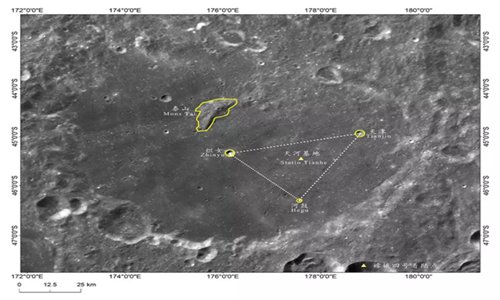Chang'e-4 landing site named ‘Statio Tianhe,’ four other lunar sites get Chinese names

A 3D illustration of the five spots on the far side of the moon named after Chinese mythological and astronomical terms. Photo: courtesy of China National Space Administration
China's space authorities announced on Friday that the landing site on the far side of the moon by the country's lunar probe Chang'e-4 has been officially named Statio Tianhe following approval from the International Astronomical Union (IAU).
The announcement was made at a press conference of the China National Space Administration (CNSA), Chinese Academy of Sciences and the IAU on Friday.
China's Chang'e-4 probe, launched on December 8, landed on the Von Karman Crater in the South Pole-Aitken Basin on the far side of the moon on January 3.
The name Tianhe, an ancient Chinese term for the Milky Way, also implies groundbreaking improvements in the outer space domain, which is in line with the fact that Chang'e-4 was the first manned spacecraft to land on the dark side of the moon, according to a release from the CNSA on Friday.
Statio Tianhe, together with Statio Traquillitatis, which is the landing spot of NASA's Apollo 11, are the only two geographic moon entities that share the title of "Statio."
Aside from Statio Tianhe, three craters arranged in a triangle around the landing site were also approved to be named after ancient Chinese mythological and astronomical terms—Zhinü, Hegu [another name for Niulang], and Tianjin.
The names come from the Chinese myth and love story of the Niulang and Zhinü [Weaver Girl and the Cowherd]. Separated by the Silver River, which symbolizes the Milky Way, the lovers were reunited for a day each year by a bridge formed by a flock of magpies - Queqiao - which allowed them to cross the heavens.

A Chinese paper cutting work depicting the story of reunion moment in the love story of the Niulang and Zhinü [Weaver Girl and the Cowherd]. Photo: IC
China named its relay satellite for the Chang'e-4 lunar probe mission Queqiao.
And the central peak of the Von Karman Crater, which is located some 46 kilometers from the landing site and is minus 4,305 meters below the lunar sea level, was also officially named Taishan after one of the five most celebrated mountains in China. It also marks the country's first time to be approved to name a "mountain" geographical entity on the moon.
China submitted the names for the five Chang'e-4 lunar probe-related geographical entities on the moon in January, which were approved by the IAU on February 4.
China has registered 12 names for lunar geographical entities under the IAU approval so far, including those from previous Chang'e-1 and Chang'e-3 missions.
Global Times
